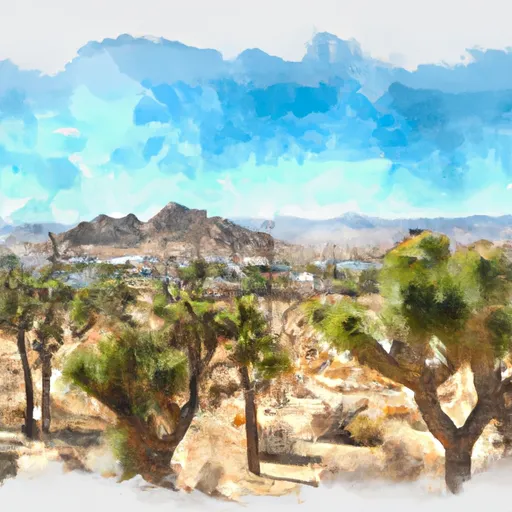-
 Snoflo Premium
Snoflo Premium
Get unlimited access to all our content
With no Ad interruptions! - Start Your Free Trial Login with existing account
Joshua-Tree
Eden Index
Climate
8.7
•
Recreation
5.2
•
Community
0.6
•
Safeguard
5.4/10

Joshua Tree is a small town located in the high desert region of Southern California, named after the iconic Joshua trees that dominate its landscape. The climate in Joshua Tree is characterized by hot summers and mild winters. Summers can be scorching, with temperatures often exceeding 100°F (38°C), while winters are generally comfortable, with daytime temperatures ranging from 60-70°F (15-21°C).
Hydrologically, Joshua Tree is part of the Mojave Desert, which is a rain-shadow desert with limited water availability. The area mainly relies on groundwater sources, such as aquifers, for its water supply.
Joshua Tree National Park, encompassing a significant portion of the town, offers a plethora of outdoor recreation opportunities. The park is renowned for its unique desert landscapes, impressive rock formations, and diverse flora and fauna. Visitors can enjoy hiking, rock climbing, camping, and stargazing. Additionally, the region attracts rock climbers from around the world, with countless boulder problems and climbing routes spread throughout the park.
In summary, Joshua Tree, California, boasts a hot desert climate, relies on groundwater for its water supply, and offers exceptional outdoor recreation opportunities within the stunning Joshua Tree National Park.
What is the Eden Index?
The Snoflo Eden Index serves as a comprehensive rating system for regions, evaluating their desirability through a holistic assessment of climate health, outdoor recreation opportunities, and natural disaster risk, acknowledging the profound impact of these factors on livability and well-being.
Climate Health Indicator (CHI): 8.7
Joshua-Tree receives approximately
164mm of rain per year,
with humidity levels near 60%
and air temperatures averaging around
19°C.
Joshua-Tree has a plant hardyness factor of
9, meaning
plants and agriculture in this region tend to thrive here all year round.
By considering the ideal temperature range, reliable water supplies, clean air, and stable seasonal rain or snowpacks, the Climate Health Indicator (CHI) underscores the significance of a healthy climate as the foundation for quality living.
A healthy climate is paramount for ensuring a high quality of life and livability in a region, fostering both physical well-being and environmental harmony. This can be characterized by ideal temperatures, reliable access to water supplies, clean air, and consistent seasonal rain or snowpacks.
Weather Forecast
Streamflow Conditions
Southern Mojave
Area Rivers
Southern Mojave
Snowpack Depths
Southern Mojave
Reservoir Storage Capacity
Southern Mojave
Groundwater Levels
Recreational Opportunity Index (ROI): 5.2
The Recreational Opportunity Index (ROI) recognizes the value of outdoor recreational options, such as parks, hiking trails, camping sites, and fishing spots, while acknowledging that climate plays a pivotal role in ensuring the comfort and consistency of these experiences.
Access to outdoor recreational opportunities, encompassing activities such as parks, hiking, camping, and fishing, is crucial for overall well-being, and the climate plays a pivotal role in enabling and enhancing these experiences, ensuring that individuals can engage in nature-based activities comfortably and consistently.
Camping Areas
| Campground | Campsites | Reservations | Toilets | Showers | Elevation |
|---|---|---|---|---|---|
| Hidden Valley - Joshua Tree National Park | 44 | 4,222 ft | |||
| Ryan - Joshua Tree National Park | 31 | 4,319 ft | |||
| Black Rock - Joshua Tree National Park | 100 | 3,962 ft | |||
| Indian Cove - Joshua Tree National Park | 101 | 3,224 ft |
Catastrophe Safeguard Index (CSI):
The Catastrophe Safeguard Index (CSI) recognizes that natural disaster risk, encompassing floods, fires, hurricanes, and tornadoes, can drastically affect safety and the overall appeal of an area.
The level of natural disaster risk in a region significantly affects safety and the overall livability, with climate change amplifying these risks by potentially increasing the frequency and intensity of events like floods, fires, hurricanes, and tornadoes, thereby posing substantial challenges to community resilience and well-being.
Community Resilience Indicator (CRI): 0.6
The Community Resilience Indicator (CRI) recognizes that education, healthcare, and socioeconomics are crucial to the well-being of a region. The CRI acknowledges the profound impact of these elements on residents' overall quality of life. By evaluating educational resources, healthcare accessibility, and economic inclusivity, the index captures the essential aspects that contribute to a thriving community, fostering resident satisfaction, equity, and social cohesion.

